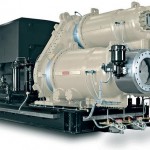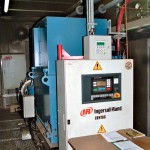In chemical plants, the required compressed air is often generated by multiple turbo-compressors. Whereas the higher-level control systems of smaller rotary screw compressors already are state-of-the-art and enable huge savings, turbo-compressors have so far still been switched on and off manually. However, a central control has now been developed especially for turbo machines that achieves potential energy savings of over 10 %, and sometimes as much as 30 %, for only a moderate capital investment.
Turbo-compressors are high-output fluid machinery, supplying operational and process air with a minimum difference in pressure. It is therefore hard finding more optimisation potentials with regard to output and energy efficiency, especially as the basic operating principle of these machines has been in use for decades and is continuously developed. Nevertheless, the Air Solutions Division at Ingersoll Rand has detected one field where action needs to be taken. Multiple rotary screw compressors are usually connected to a central control, which switches the individual devices on and off according to the compressed air demand. Practice has shown that this procedure enables considerable volumes of energy to be saved, so that the control quickly pays for itself. In stations with multiple turbo-compressors, the compressed air supply is usually matched to the compressed air demand in the traditional way: the user switches the individual devices on or off manually. At the same time, this method excludes all feedback, as the actual demand is considered, and furthermore prevents the establishment of an efficient regulation process.
No off-the-peg solution
Ingersoll Rand’s master control fills a market gap. This tool automates control of the compressors and the processing units in the compressed air station. In addition to Centac turbo-compressors, equipment from any manufacturer can also be integrated and the system is moreover suitable for upgrading existing compressor stations. In contrast to the control units for rotary screw compressors, the master control is not a ready-made, off-the-peg solu-tion. Every single control offers different functionalities. Despite this, the engineers in Mulheim/Ruhr did not have to start from scratch: they were able to revert to a basic system covering approximately 50 to 60 % of all desired or required functionalities.
In order to fully exploit the available energy saving potentials, intensive preliminary work is essential. First, the load profiles are calculated using modern measuring equipment. As both the compressed air volumes and the energy consumption are measured, optimal load cases can be assigned to individual compressors, which is a prerequisite for installing the master control. The hardware and software basis also must be defined during the preparatory stage of the upgrade. Ingersoll Rand recommends a Siemens S7 PLC in combination with WinCC-based process control technology, although other standards are possible as well. During this phase, it is equally important to define how the individual equipment will be integrated in the system, whether processing units will have to be included and whether an upgrade of the control technology is required or useful for older turbo-compressors. The CNC control used by Ingersoll Rand for the Centac compressors is additionally suitable for machines from other manufacturers. The preliminary work also includes the definition of the measuring points and the reference input, which are decisive for compressor control. The integration of the master control in higher-level systems (process control technology, visualisation, energy management etc.) must likewise be defined at this stage.
After completing these tasks, the control technology experts from Ingersoll Rand draw up a specification, which describes the functions of the master control in detail. Once this specification has been completed together with the user, the implementation phase can begin. The hardware of the compressed air system is optimised in addition to the control technology, assuming this is necessary and feasible. The optimisation activities could include a leak test of the compressed air lines, for instance. In the course of this test, which is offered by Ingersoll Rand as a special service, the company’s technicians nearly always find leaks affecting the efficiency of compressed air generation. The pipelines and connections are also inspected for possible bottlenecks or constrictions that could influence the flow. All these measures and checks are intended to increase energy efficiency. The master control enables considerable savings to be realised: only the compressors actually needed for each specific load case are operated, and idle times and blow-off processes are minimised. At the same time, the interlinking and central control of the turbo-compressors ensure that each machine always runs in the most eco-nomical range. Up to 10 % energy can be saved in this way with plants that were previously optimally controlled using conventional methods. Since turbo-compressors require powerful drives to generate the enormous volumes of compressed air despite their economical operating principle, the potential saving adds up considerably. The effect is even more impressive when it comes to compressed air stations without optimal control. Here, the master control saves anything from 30 to 40 % electricity. The actual saving can moreover be visualised in black and white on the screen. The numerous options and special functions for the master control include a detailed cost calculation that can be exported to Excel spreadsheets, for instance. Energy management for multiple pressure levels, i.e. compressed air stations generating several pressure stages, is similarly possible.
Practical example
Ingersoll Rand has interlinked an existing compressed air plant for a German chemical company. The five turbo-compressors – four from Ingersoll Rand, one from another manufacturer – and two older rotary screw compressors are distributed between two compressed air stations in two different buildings and generate an air volume of approximately 18,000 Nm3/h. In order to ensure the continuity of the compressed air supply, all machines are normally operated simultaneously. The user wanted to realise central energy management for both compressed air stations, a wish that Ingersoll Rand was able to fulfil with the master control. Day and week profiles were defined on the basis of compressed air and energy consumption measurements and assigned to the respective optimal compressor combinations. They ensure that the required amount of air is always effectively and efficiently available, regardless of whether the entire station is running at high or low capacity. The control itself is installed in one of the two stations. The other station is equipped with a control cabinet, which gathers relevant data and transmits it to the master station with the central control over a fibre optic cable. The control technology of the two rotary screw compressors was previously upgraded to make them suitable for interlinking. The control operates on the basis of a Siemens type S7–400 PLC. A convenient solution using WinCC was implemented for operator control and monitoring: all information is object oriented and graphical.
Without interrupting production
The master control was installed in a period of less than six months, all preliminary work included. Like many other compressed air users, the company could not afford to have its air supply interrupted. The implementation therefore had to be completed without interrupting production. After installing the control, the compressors were connected one after the after. Next, the individual parameters were set and adjusted – with production still going strong – in order to ensure optimal operation of the entire compressed air plant from a technical and commercial point of view. According to initial evaluations, the company will be able to cut its air-related electricity costs – equivalent to between 60 and 70 % of the lifetime costs of a compressed air station – by approximately 30 %. With seven compressors generating an overall air volume of 18,000 Nm3/h, this amounts to an altogether impressive sum, as a result of which the master control will quickly pay for itself.
This application is rather atypical in view of the fact that particularly high energy savings are realised despite compressed air generation being distributed between two buildings and two compressed air stations. A second, more representative example gives a better idea of the benefit that can be achieved with the master control in a modern, high-performance compressed air plant. At the factory of a major corporation, eight turbo-compressors – including seven Centacs – generate a compressed air volume of 40,000 Nm³/h. In this case, the user stipulated an energy saving of 10 % as a condition for installing the master control. This value is actually exceeded in practice. Even if the compressed air demand is reduced by only 12 or 14 %, the reduction in energy costs is considerable if one considers the large volumes of compressed air consumed.
Ingersoll-Rand GmbH info@ingersollrand.de http://company.ingersollrand.com
Share:








